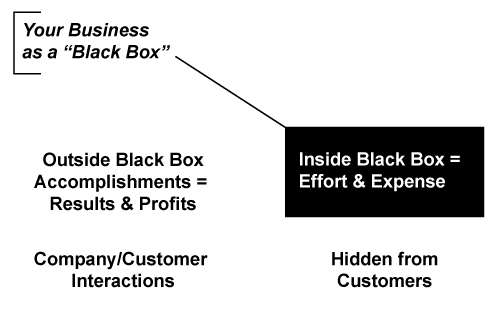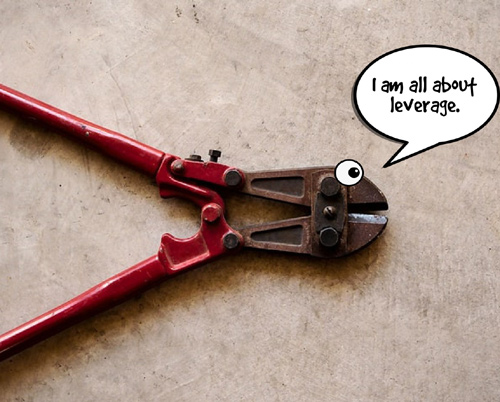Thought Leadership Studio Blog Posts:
Pullfillment - Why Your Business is a Black Box
No matter what your business ...Profits result from what it creates outside of it. That's where your customers are and where they experience the benefits. Extend this philosophy to your web content and prosper.

#marketingstrategy, #pullfillment, #strategicthoughtleadership, #systemsthinking, #thoughtexperiments, #thoughtleadershipmodel
Profits result from what a business creates that's outside of it. That's where the customers are and where they experience the benefits.
Inside the black box, invisible (and irrelevant) to customers, is effort and expense.
The single most important thing to remember about any enterprise is that there are no results inside its walls. The result of a business is a satisfied customer. - Peter Drucker
 From a certain angle this is being Captain Obvious. From another, it's completely outside the too-common mindset of top-down management and its close relative, data-targeting online marketing. I'm taking you down this path for a good reason, though: Follow the road long enough and, just outside of the neon lights and city sounds of the metaphorical town of "how most people market", we'll find ways to generate breakthroughs similarly outside the norm in sales, marketing, persuasion and market leadership.
From a certain angle this is being Captain Obvious. From another, it's completely outside the too-common mindset of top-down management and its close relative, data-targeting online marketing. I'm taking you down this path for a good reason, though: Follow the road long enough and, just outside of the neon lights and city sounds of the metaphorical town of "how most people market", we'll find ways to generate breakthroughs similarly outside the norm in sales, marketing, persuasion and market leadership.
It's a worthwhile trip, so buckle up. If you don't mind me talking while I'm driving ...
Remember a time when you broke out of a habit pattern to find greater success? How about a time when your world changed due to changing a belief? Can you be surprised at the realization that breakthroughs usually come from outside the "normal" frames of reference? Shifting frames of reference isn't like just driving between cities, it's more like the shift in culture of crossing national boundaries. It's like we left Tijuana, with it's unfortunate poverty everywhere such as people living in boxes by the rushing river, and crossed a line into San Diego, where, suddenly, we are surrounded by gleaming prosperity.
The prospect of such a breakthrough or 3 in marketing, sales, lead conversion, or lead generation is usually enough encouragement to get forward thinking types to suspend their assumptions and cross such invisible lines. Like my successful business consultant friend, Ray, used to say, you can leave your beliefs in the box by the door when you come in. While you are here, see things without those filters. If you still think they are worth keeping afterwards, they'll be there for you to pick up on the way out. Still here? Great. Stay with me on this path and things will begin to make perfect sense.
 I should put it in reverse and back up a bit, first, as I remember that sometimes Ray's clients had problems finding their old beliefs after the session. Apparently, one time the cleaning crew emptied out the box during the meeting, thinking it was trash. That entire mastermind group had to go back to their lives without their limitations. Some of them doubled or tripled sales over the next year.
I should put it in reverse and back up a bit, first, as I remember that sometimes Ray's clients had problems finding their old beliefs after the session. Apparently, one time the cleaning crew emptied out the box during the meeting, thinking it was trash. That entire mastermind group had to go back to their lives without their limitations. Some of them doubled or tripled sales over the next year.
OK, onward in our journey to breakthroughs from shifting gears in mindset. Yes, this car has a manual. I like the feeling of being in touch with the car by controlling the transmission directly. How about you? On the other hand, I can appreciate the ease of cruise control for longer journeys. Once you have things set right, you can let the system take over.
Profits Outside/ Expense Inside. Where should your focus be?
 So, for the purpose of this thought experiment, let's keep the focus outside by imagining your business is a black box . . . with all that matters exterior to it.
So, for the purpose of this thought experiment, let's keep the focus outside by imagining your business is a black box . . . with all that matters exterior to it.
One important benefit of this perspective is better enabling the systems view so we see the big picture of your prospects' and customers' interactions with your business (or business you are representing) - and the business itself, including its marketing media - as an integrated whole.
That systems view brings very different insights when contrasted with the much more typical reductionist thinking that breaks things into separate components. The problem with breaking things into components - and the associated 1-directional thinking - is that systems - which are circular, not 1-directional - have dynamics that escape such rational analysis. They seem to have a mind of their own.
In this context, a system is an associated set of parts that work together for a common system purpose...parts that are connected via feedback loops. Those feedback loops are two-way streets and we miss that, along with being able to sense and utilize potentially counter-intuitive system dynamics, unless we take such a "whole systems" view.
 If we take the time to play with and understand systems dynamics, however, solutions we would have otherwise missed appear, often in the guise of leverage points that offer great results with seemingly little work. It can be like finding a door to a room full of light after unseemly effort - with accompanying grunts and cursing - pushing against a damp, cold, moldy-smelling wall. Isn't it smarter to look for the door when old approaches seemed like being trapped in a dark alley? Maybe that light reveals a potential breakthrough that was in the shadows.
If we take the time to play with and understand systems dynamics, however, solutions we would have otherwise missed appear, often in the guise of leverage points that offer great results with seemingly little work. It can be like finding a door to a room full of light after unseemly effort - with accompanying grunts and cursing - pushing against a damp, cold, moldy-smelling wall. Isn't it smarter to look for the door when old approaches seemed like being trapped in a dark alley? Maybe that light reveals a potential breakthrough that was in the shadows.
And, speaking of systems dynamics, consider the system purpose of the business or organization you represent... or, yourself in that role, if you are a solopreneur. Is it simply to make money? That is sensible from a top-down, reductionist view. However, when you consider that the systems view reveals it is the customer who sets the value, it will actually make more money when the system purpose is to deliver value from the point of view of the paying customer. That was one of the insights of the Vanguard Group, a consulting firm in the UK that, under the leadership of its founder, John Seddon, translated the systems view of luminaries like Edward Deming - as applied to manufacturers like Toyota - to services, with their very different needs.
Seddon and the Vanguard Group found some powerful leverage points when they applied systems thinking to service businesses. These include:
- Design to Demand: Study demand from the customers' point of view and develop services that meet it. This is what I call Pullfillment: Fulfilling the pull of customers.
- View and design the business from the outside in- the customer point of view - rather than top-down.
- Toss out typical performance goals and replace them with goals that measure performance in customer terms. The types of goals we were aiming for before become emergent from the system, and can surpass previous performance by a quantum leap.
- Think in terms of economies of flow instead of economies of scale ... and you'll be more likely to get that scale you were aiming for.
- Instead of the usual planning and budgeting, work on the system from the customer viewpoint, eliminating all that doesn't contribute to value in customer terms. This will drive out waste and costs better than the typical budget planning.
And what if we draw the system-defining circle around the business a little larger so it also includes its internet media? What if we consider that media also as a service provided to customers who pay, in this case, (and while moving towards a purchase) with their interaction and attention?
We find prospects similarly set the value of our web media through their choice to give it time and engagement. Similar leverage points apply. And similar breakthroughs can happen.
This opens the door to get further leverage through Strategic Thought Leadership, which is helpful when the customer has a want you can fulfill with not just a product or service, but also a fresh way of thinking about it. This can beget a content or PR program that shapes market demand and behavior to your advantage. More on that in subsequent posts. (Or you can grab this Free Marketers' Guide.)
For now, let's carry on ...
Customers Pull for What They Want: Pullfillment
 People take action by "pulling" to get what they want from companies. Customers "pull" from companies in order to create the desired Pullfillment: the experience of satisfying their values or achieving a desired state through using the product or service.
People take action by "pulling" to get what they want from companies. Customers "pull" from companies in order to create the desired Pullfillment: the experience of satisfying their values or achieving a desired state through using the product or service.
I think "pull" is a better word than customer "demand" since demand might be construed as a whim, a mere want that falls far short of action to fulfill it. It is only when that desire turns into action - in particular the willing giving of money, time, and other resources - that it becomes real enough to be "pull".
So pull is action to satisfy that demand for a product or service. Even if a company sends a sales force out to push for new business, it only benefits with new sales if prospects pull in response.
In this frame, your sales and marketing effort can be thought of as aiming to elicit pull.
Customer Experience (AKA CX in marketing acronym-ese) is a popular terms in some circles. The problem is we need to relate the experience to the satisfaction of a particular flavor of pull. So Pullfillment continues to be a better word for our purposes..
With that in mind, let's explore a deeper understanding by using a systems view of pull and the resulting pullfillment. Check out this graphic:

This image shows the pull-to-pullfillment conversion engine "black box" that inputs pull and outputs pullfillment. A good black box makes a lot of pullfillment with relatively little pull. An inefficient black box needs a lot of pull to create relatively little pullfillment.
 Consider it a simple vending machine. It's as if customers are putting money, time and trouble into that vending machine like a few quarters to get a cold Diet Coke: the intended pullfillment. But, as the can loudly clunks its way out, they see it is a regular coke instead. Or, if it's the right drink, the first grab of the can reveals it to be lukewarm instead of the reassuring bite on the hand of ice-cold aluminum as expected. Or the machine eats their quarters with a gurgle then silently smiles back with a look that says "ha ha" instead of providing any drink at all. Infuriating, especially when the cashier inside similarly shrugs his shoulders and won't give a refund. "Not our machine ... they are here once a week to collect the money."
Consider it a simple vending machine. It's as if customers are putting money, time and trouble into that vending machine like a few quarters to get a cold Diet Coke: the intended pullfillment. But, as the can loudly clunks its way out, they see it is a regular coke instead. Or, if it's the right drink, the first grab of the can reveals it to be lukewarm instead of the reassuring bite on the hand of ice-cold aluminum as expected. Or the machine eats their quarters with a gurgle then silently smiles back with a look that says "ha ha" instead of providing any drink at all. Infuriating, especially when the cashier inside similarly shrugs his shoulders and won't give a refund. "Not our machine ... they are here once a week to collect the money."
There's the anticipated pullfillment and then there's the actual pullfillment. When they're not the same thing, there's a pullfillment gap.
Fortunately, a Pullfillment Gap can also go the other way. And when you create a Positive Pullfillment Gap, you can set new standards in a niche so - You and your company are seen as if in a spotlight, above and apart from the rest of the field and
- Your messages cuts through the cacophony of the internet so it is heard loud and clear by your prospects.
Up next: Understanding and using the Pullfillment Gap can transform both marketing results and customer experience. (members only - free with registration)

Member-only content: How Understanding and using the Pullfillment Gap can transform both marketing results and customer experience.
Click here to login to view. Don't worry, I'll wait for you. You'll return to here, and the content will appear . Need a membership for thee?
Click here to register for free.
***************************************